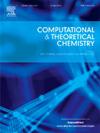提高含氮金碳化物笼的热稳定性:Au30N20C60与Au30C20C60的DFT研究
IF 3
3区 化学
Q3 CHEMISTRY, PHYSICAL
引用次数: 0
摘要
在BP86/6-31 g(d)和BP86/def2-TZVPP条件下,分别构建了Au30N20C60和Au30C20C60两个典型的三角六面体类金碳化物簇。Au30N20C60和Au30C20C60保持架的振动频率分析未发现虚频率。模拟的红外光谱和拉曼光谱也可为进一步勘探提供理论依据。分子动力学模拟结果表明,经过20 ps NVT MD模拟后,Au30N20C60维持原有构型和亚基的最高温度为1200 K,明显高于Au30C20C60的900 K,表明掺杂N原子增强了金碳化物团簇的热力学稳定性。从态密度、电子密度和自适应自然密度分配等方面对Au30N20C60的电子性质进行了讨论,可以清楚地解释其电子行为。本文章由计算机程序翻译,如有差异,请以英文原文为准。

Enhanced thermal stability in nitrogen-containing gold carbide cages: A DFT study of Au30N20C60 vs. Au30C20C60
Two typical deltoidal hexecontahedron-like gold carbide clusters of Au30N20C60 and Au30C20C60 cages have been constructed under BP86/6-31 g(d) for C, N atoms and BP86/def2-TZVPP for Au atoms in this work. No imaginary frequencies have been found in the vibrational frequency analysis for Au30N20C60 and Au30C20C60 cages. The simulated IR and Raman spectrum may also provide theoretical basis for further exploration. Molecular dynamics simulations show that the highest temperature at which Au30N20C60 maintains its original configuration and subunits after 20 ps NVT MD simulations is 1200 K, which is significantly higher than the 900 K observed for Au30C20C60, indicating that the doped N atoms enhance the thermodynamic stability of gold-carbide clusters. The electronic properties of Au30N20C60 has been discussed via density of states, electron density, and adaptive natural density partitioning, which can clearly explain its electronic behavior.
求助全文
通过发布文献求助,成功后即可免费获取论文全文。
去求助
来源期刊

Computational and Theoretical Chemistry
CHEMISTRY, PHYSICAL-
CiteScore
4.20
自引率
10.70%
发文量
331
审稿时长
31 days
期刊介绍:
Computational and Theoretical Chemistry publishes high quality, original reports of significance in computational and theoretical chemistry including those that deal with problems of structure, properties, energetics, weak interactions, reaction mechanisms, catalysis, and reaction rates involving atoms, molecules, clusters, surfaces, and bulk matter.
 求助内容:
求助内容: 应助结果提醒方式:
应助结果提醒方式:


